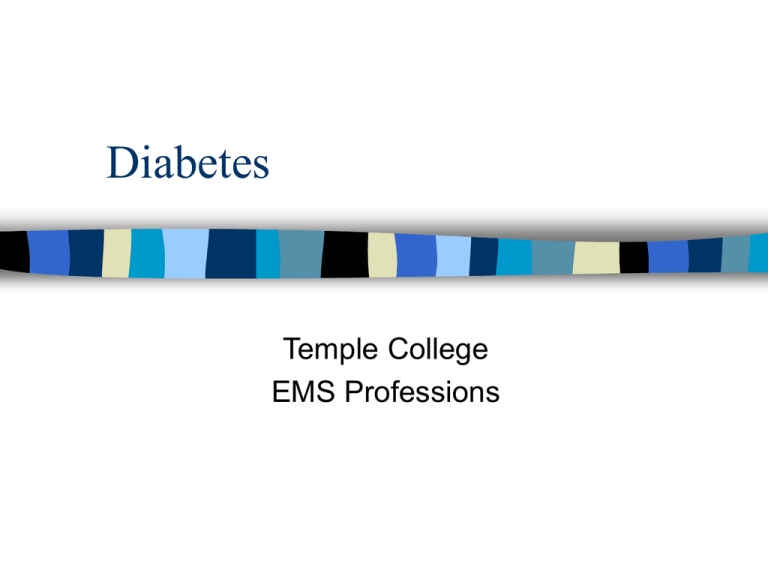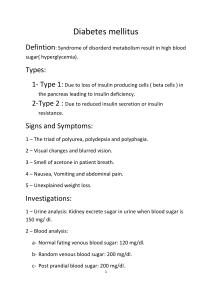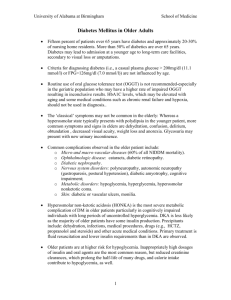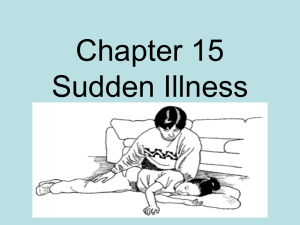Diabetes
advertisement

Diabetes Temple College EMS Professions Glucose Required as fuel for cellular metabolism Brain’s need for glucose parallels its demand for oxygen Insulin Hormone Produced by Islets of Langerhans in pancreas Required for sugar to enter most cells Brain does not require insulin to use sugar Pancreas Located in retroperitoneal space Produces, releases – Digestive enzymes into duodenum – Insulin, glucagon into blood Islets of Langerhans Alpha cells – Glucagon – Raises blood sugar Beta cells – Insulin – Lowers blood sugar Diabetes Mellitus Metabolic disease Characterized by inadequate, absent insulin production Type I Diabetes No insulin production Takes insulin injections Type II Diabetes Inadequate insulin production Increased tissue resistance to insulin effects Controlled with – Diet – Oral medications: • Diabeta, Diabinese, Dymelor, Glucotrol, Micronase, Orinase, Tolinase, Glucophage – Insulin injections as disease progresses Problems in Diabetes Blood Sugar Imbalance Hyperglycemia – Diabetic ketoacidosis (DKA) – Hyperosmolar coma Hypoglycemia Hyperglycemia Causes – Failure to take insulin – Overeating, eating wrong diet – Stress (fever, infection, emotional stress) New-onset diabetics usually present with an episode of hyperglycemia Diabetic Ketoacidosis Usually Type I diabetic (no insulin) Blood sugar rises Kidneys try to remove excess sugar Urine production increases (polyuria) Patient becomes volume depleted – – – – Thirst (polydypsia) Tachycardia Hypotension Dry skin, mucous membranes Diabetic Ketoacidosis Cells cannot burn sugar; patient experiences hunger (polyphagia) Cells burn fat as alternative fuel Acidic ketone bodies produced Patient tries to correct acidosis; exhales CO2 Rapid, deep breathing (Kussmaul respirations) Exhaled ketone bodies produce nail-polish remover or “fruity” breath odor Diabetic Ketoacidosis Volume depletion Ketone body production (ketoacidosis) Hyperosmolar Coma Usually Type II diabetic (inadequate insulin) Blood sugar rises Kidneys try to remove excess sugar Urine production increases (polyuria) Patient becomes volume depleted – – – – Thirst (polydypsia) Tachycardia Hypotension Dry skin, mucous membranes Hyperosmolar Coma Cells continue to burn sugar Acidic ketone bodies not produced Nail-polish remover or “fruity” breath odor not present Hyperosmolar Coma Severe volume depletion NO ketone body production Hyperglycemia Management – Support ABC’s – Treat for hypovolemic shock – Transport – When in doubt, give sugar! Hypoglycemia Causes – Insulin overdose – Normal insulin use without eating – Over-exercise Hypoglycemia Blood Sugar Falls Brain lacks adequate glucose Adrenal Glands release Epinephrine Alterations in consciousness; Seizures; Headache; Unusual Behavior Pale; Cool skin; Sweating; Tachycardia; Increased BP; Nausea Pale, cool skin; sweating; nausea; tachycardia Is that why hypoglycemia sometimes is called “Insulin Shock?” Hypoglycemia Insulin shock isn’t really shock Patient just looks “shocky” because of epinephrine adrenals are releasing Hypoglycemia Can occur in non-diabetics Most common cause = EtOH on empty stomach A patient is never, just drunk Hypoglycemia Management Conscious patient – Give sugar orally Unconscious patient – Support ABC’s – Get ALS back-up for IV glucose When in doubt, Give Sugar! Ask All Diabetics Have you eaten today? Have you taken your medication today? When in doubt, give Sugar! Other Diabetes Complications Atherosclerosis – Myocardial infarction – CVA – Peripheral vascular disease – Blindness – Renal failure Other Diabetes Complications Diabetic Neuropathy – Gangrene – Increased “silent” myocardial infarction risk Silent MI Acute MI in diabetic can present without chest pain May resemble “flu” Manage “sick” diabetics as if critically ill until proven otherwise






